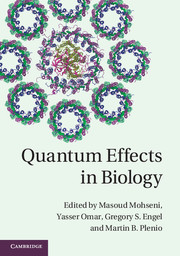Book contents
- Frontmatter
- Contents
- Foreword
- Contributors
- Preface
- Part I Introduction
- 1 Quantum biology: introduction
- 2 Open quantum system approaches to biological systems
- 3 Generalized Förster resonance energy transfer
- 4 Principles of multi-dimensional electronic spectroscopy
- Part II Quantum effects in bacterial photosynthetic energy transfer
- Part III Quantum effects in higher organisms and applications
- References
- Index
3 - Generalized Förster resonance energy transfer
from Part I - Introduction
Published online by Cambridge University Press: 05 August 2014
- Frontmatter
- Contents
- Foreword
- Contributors
- Preface
- Part I Introduction
- 1 Quantum biology: introduction
- 2 Open quantum system approaches to biological systems
- 3 Generalized Förster resonance energy transfer
- 4 Principles of multi-dimensional electronic spectroscopy
- Part II Quantum effects in bacterial photosynthetic energy transfer
- Part III Quantum effects in higher organisms and applications
- References
- Index
Summary
Introduction
Decades of effort in structural biology and ultrafast spectroscopy have elucidated many details of natural photosynthesis (Blankenship, 2002; Hu et al., 2002), and it is now a well-established fact that the initial light-harvesting process that leads up to the collection of energy at reaction centres, where charge transfer reaction occurs, is a process with almost perfect efficiency. The mechanism underlying the energy migration in a photosynthetic system is a fundamentally quantum-mechanical one, known as excitation energy transfer (EET) or resonance energy transfer (RET) (Silbey, 1976; Agranovich and Galanin, 1982; Scholes, 2003; May and Kühn, 2011; Olaya-Castro and Scholes, 2011).
Resonance energy transfer is ubiquitous, and had been observed as sensitized luminescence long before modern quantum-mechanical understanding of molecular systems was established (Agranovich and Galanin, 1982). Normally, when a molecule becomes excited electronically by absorbing a photon, it luminesces by emitting another photon, within about a nanosecond, if it is fluorescence, or much later for phosphorescence. However, when another molecule with similar excitation energy is present within a distance of tens of nanometres, it can swap its excitation with the molecule as follows:
D∗ + A → D + A∗,
where D∗ (D) is the excited (ground) state donor of the energy and A (A∗) is the ground (excited) state acceptor. Thus, the excitation of D sensitizes that of A.
Clear and sensible understanding of the RET process had been beyond the reach of classical mechanics as had any other molecular processes involving matter–radiation interaction.
- Type
- Chapter
- Information
- Quantum Effects in Biology , pp. 53 - 81Publisher: Cambridge University PressPrint publication year: 2014

